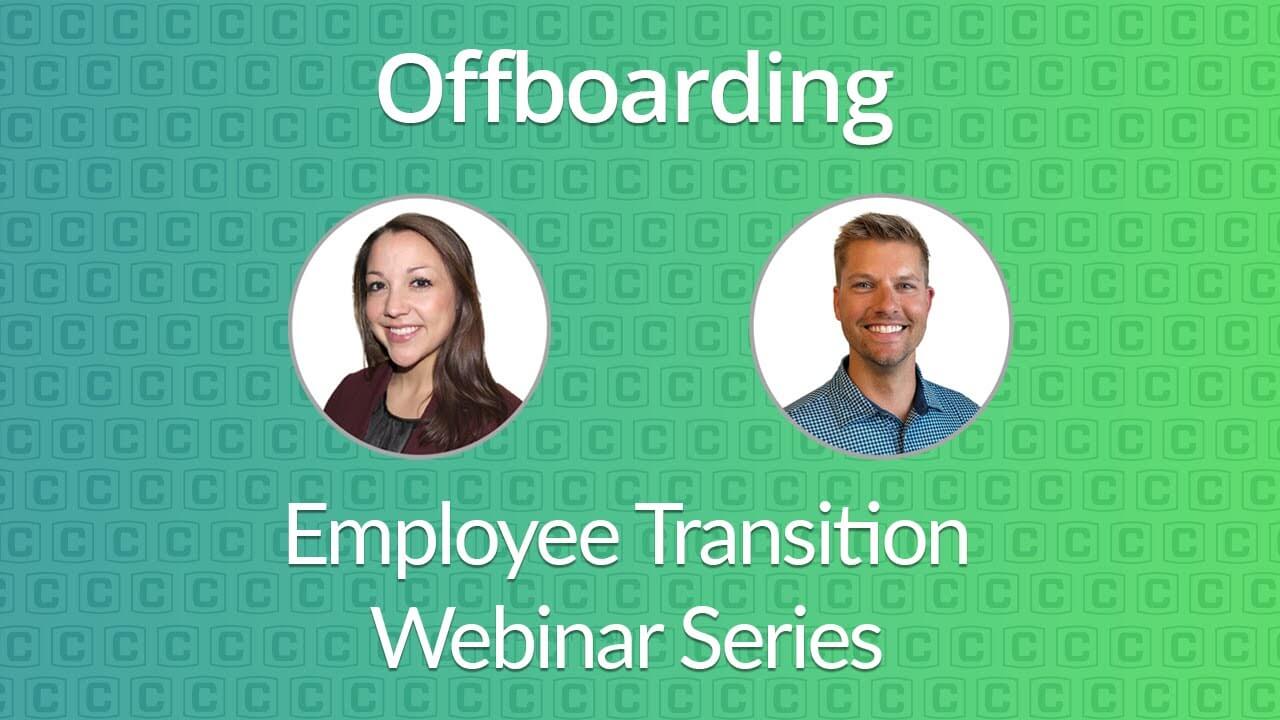Employee Transitions Webinar: Offboarding
Realize the importance of intentional exit experiences. Learn how to leverage data and asset collection to support procurement, provisioning and sharing of critical resources.
Video Transcription:
MICHELLE: Thank you everyone for joining us. We really appreciate you taking time out of your day. I know everyone is incredibly busy, so we really appreciate it. First, let’s start with some introductions. Obviously we’re Click Boarding! I’m Michelle. I’m with our Marketing & Communications team.
My favorite part of my job is doing sessions like this, getting in front of HR professionals – like all of you talking about our use cases and how we help clients. So super excited to be here today to talk about offboarding, and I’ll hand off to Jeff.
JEFF: Yes, I’m Jeff Borra, Vice President of Business Development here at Click Boarding. Very excited to have all you here today to join us, and for those that are going to be working through the recordings as well, we’re really excited to get through our third session here in our webinar series! My background’s been in human capital, employee engagement, recruitment, staffing for 15 years. So I’ve seen really, really where our product can help influence you all from beginning to end.
We’re working through offboarding today and excited to answer any questions along the way that you all may have and work through this together.
MICHELLE: Awesome, thanks, Jeff. Just a bit of housekeeping: feel free to chat with us throughout. I just sent a message to everybody. We’d be happy to take your questions at the end of a couple demos we’re going to run through. As Jeff mentioned, we’re talking about offboarding today, so it’s important to start with the definition of that. I know everyone uses different language, vernacular…dependent on the company you’re in.
We are showing a couple activities that are specific to offboarding that you can administer through the Click platform. We define offboarding as any exit – whether permanent or temporary, whether that be a reduction in your workforce, retiring team members or losing talent – either voluntarily or involuntarily. In those moments, it’s important to offboard with intention, with empathy and in a cohesive fashion.
So today, Jeff is going to show two different offboard activities. We’ll pause in between. The first of those is going to be a voluntary offboard experience for someone that chose to leave the organization on their own accord. Jeff will showcase some of the tactical steps that need to be completed from a compliance standpoint, as well as some of the engagement steps, in order to share content and ensure that you are facilitating an exit in a positive way – as best you can – upon exiting. With that, I am going to share my screen and I will hand off to Jeff.
JEFF: Well, again, thank you for joining today! With voluntary offboarding, we’re going to work through this together, right? And just to reiterate, we’re talking voluntary. We also have involuntary. There’s all kinds of different transitions that we’re going to be going through with offboarding, but for now, let’s concentrate on voluntary.
What we’re going to be doing here, what we’re showcasing in terms of creating a new updated password.
Security questions just from a compliance perspective as we are in voluntary mode here, so we’re going to be creating some new subsets as system access may have been turned off. We’re going to be resetting that up to confirm and deliver these messages. Again, we can deliver it via mobile or we can deliver it via any device that has internet capability.
Again, we are not an app, so what you’re seeing today is going to be transitioned through the internet via computer. What you’re seeing here is in terms of the transition. We’re going to be looking at means of communication, back and forth. As we fully automate this, we’re going to look through exit surveys.
Now, it’s going to be really important for us to build these questions around what avenues we’re creating here.
With voluntary, you have the ability to build and create your own data flows; you can change the questions however you want to. You’re seeing different dropdowns right now that we’re going through. Now, these can be fully customized and created based on your own needs. With these surveys, we’re going to want to gather the information that we’re getting from the voluntary leave and utilize that for our own internal means.
There are things we can change or things we can work on. We’re going to keep it houseless information and have it ready to go and utilize some of the information we’re gathering to build and create it further.
Personal information: if we do need to touch base with these folks as they voluntarily transition away, we’re going to want to make sure we have all the personal information updated and ready to go. So through those means, we’re going to be able to get that gathered. As we transition, you’re going to see what the document can look like. Again, all this is going to be saved in-house for you at any point to gather along the way.
Again, really what we want to do is even though folks are voluntarily leaving, let’s leave it on a good note. Let’s allow them the opportunity to fully access any links or information that we have, whether it’s alumni information, whether it’s via social media. Let’s make sure that they still continue to stay engaged with us.
Right now, this is our electronic signature. This does come with purchase of the product. It’s our own proprietary eSignature that you can use for forms, documentation, sign off…at any point in time. It’s going to be set in terms of timing as well, so at any point, someone can sign this via their mouse, which is what you’re seeing here. Or you can do it via your finger on your cell phone. Again, you can transition this through your cell phone too.
Right here is the resignation letter that we’re going to house and save. They can either upload this information or they can take a picture of it with their phone and send it in, just to make it an easy process for them as we work through it.
Now, frequently asked questions: we’re going to get a lot of questions that come through, right? The easiest way to do that is to automate through some of the information gathering that we can provide to these employees that are transitioning away. Any information that we do need to let them know about, let’s get this in through any FAQs or documentation that we need, and they can actually access this back at any point in time, even following the transition.
What you’re seeing here is they can fully download this information. This is a departure checklist. We’re going to make sure we get our assets returned properly. We’re going to make sure the transition is compliant in terms of how we need it. They’re also getting that information housed personally to them via download.
As you’re seeing, here’s the downloaded departure checklist that they’ll be going through. In terms of another important piece of it, we have the ability to integrate with a lot of different systems, including your ticketing, transition and checklist here. So if we are transitioning folks out of systems or we’re gathering different assets, we can easily gather that through this means here versus manual, which is what we’re hearing a lot of – manual labor that goes into these transitions back and forth. Health coverage being important as well. If they’re transitioning over into, you know, different questions they need in terms of their coverage, they’re going to have all that as well.
Again, you can build and create as many different workflows and forms and information that you want to through these transitions. A lot of these examples you’re going to see are things that will help you through in building and creating this. But on top of that, you can build and create yourself with an easy standpoint.
Again, you can put your own pictures, videos – whatever you’d like to – to create your own branding. But again, it’s really identified around building an experience, voluntary, involuntary, furloughs…what have you. You’re going to be able to build and create this and customize it however you’d like to. But the easiest approach here is let’s automate it for you.
Let’s keep that information where we and our team have the ability to access it, but even more so as well as those employees have the ability to access it.
MICHELLE: Awesome. Thank you, Jeff. I’m going to go ahead and stop screen share so we can take a couple questions, and I see a couple of additional people joined us.
Thanks to everyone who hopped in and came to experience offboarding with us today. A couple questions came through the Q&A functionality here, so please do keep those coming and I’ll lob the first to you, Jeff. Great question: can we add our own data fields if we need to collect unique information tied to our own company?
JEFF: Absolutely, yes, great question! Again, there’s a ton of customizability with what we’re showcasing today. If you’re trying to gather different data fields or different subsets of questions that we need to get answered on, absolutely. You can build and create those however you’d like to, and it’s really going to be catered around your process, your needs.
That’s something that we’re going to help you with, but it’s also something that’s easily accessible for you to change on your own as you transition and build different workflows. We can do that based off of – maybe a longer extended answer here – but you can base those questions off of position, location, hiring manager, team members.
We can customize these workflows and these questions however we’d like to.
MICHELLE: Awesome! Great question. And yes, outside of the data fields themselves, we also have 120 standard forms that include variations of typical fields. The example that Jeff showed here in regards to the personal information is one of our standard forms that comes pre-baked, ready to deploy right out of the system.
Another question here. How are the document uploads managed in the back end of the system, in this case, tied to the resignation?
JEFF: Absolutely. So again, we’re talking about the resignation letter, but this can be any forms and information that is either being signed or sent and needs to be housed and delivered.
We have a lot of different ways we can do this, and obviously with compliance being as important as it is and security, we want to make sure that information could be moved over properly. We can save that and move it over into Safe House SFTP server for you to directly access. You’re going to get all of the forms and information, in addition to a full-based manifest of all of the information and forms that have been filled out.
Now we’re talking about the onboarding. So again, you can access this for pre-boarding, onboarding, some of the other transitions we’ve gone through in our other webinar series; that’s not going to change. You’re going to have it all saved and housed in a safe spot for you to fully access it. On top of that, we have a lot of other options as well if we need to move this information over directly for you.
Let’s do that through the biggest opportunity that we have: through integrations. We integrate with many, many different systems, big and small. And if we need to move that information over and have it subset properly, let’s do that for you. A lot of different options here for you to take on, and we’re ready to help you transition that as well.
MICHELLE: Awesome. Thanks, Jeff. And similar question, but more in regards to the employee that’s exited: how long will they have access to documents that they put into the system since they are voluntarily exiting?
JEFF: We can change this access however we want to, but if you’d like for them to have that access through, through the full lifecycle, they can have that access for any information that they have documented and filled out themselves. So they can reference back to it which, in many cases, eliminates a lot of manual tasks and labor that goes into it.
So many people are calling in saying, “Hey, where’s my information? How do I get it? How do I gather it?”
Let’s get rid of all those questions! Let’s get rid of all the manual follow up that you’re hearing from the team! Let’s create a personalized experience that they can count on. So yes, we can change that access however we’d like to. But to answer your question, we can create it however we’d like.
MICHELLE: Awesome, and I think that’s all the questions for our first workflow. Thanks everyone for submitting again; keep ‘em coming! We’ll address them as we go.
Now we want to show another example of an offboarding activity. Again, these include leave of absence, retirements, RIFs. I know we’ve all seen the recent noise around the Twitter RIF and how that should have been done….much more compliantly and empathetically. Definitely a hot topic right now!
The next one we’re going to walk through is an employee furlough experience in which they’re exiting for a period of time. We saw a lot of this obviously during Covid, and it can be high for industries that have a great deal of seasonality, but another great example to dive into. Let me share my screen again and hand off to Jeff.
JEFF: Absolutely, and furloughs as well, right? We’re going to be creating a customized experience, based on what this offboarding looks like.
If we’re looking at offboarding via a furlough, let’s make sure we transition this properly, because this could be a very short-term assignment where they’re moving off enrollment here. But we want to make sure that they’re sticking with us and that they know we’re here to take care of them along the way and through that transition.
As you can see, we’re having all the updated information that they can fully access the system. It’s all tasks you have seen before – to move them through an easy transition here as they’re temporarily leaving. We’re going to be able to put all of the necessary information in: who to reach out to, who to support for this and that, etc.
Your notice of furlough. This is going to identify the period in terms of a furlough. How long is my furlough? Who do I need to reach out to for access and information, you know; whether it’s via insurance, whether it’s via support system, what happens to my paid time off? Let’s get all those questions answered for them.
This is a very stressful time for some folks, even if they aren’t transitioning away for a short period of time. With that in mind, again, we want to make sure we have all of the necessary and correct personal information to reach out to them. If we need to reach them at any point, let’s make sure we have all that necessary information and it’s all updated properly for us to reach out to them.
Again, if you want to keep this personalized, then you can pre-populate the information, whether it’s city, state, region…we can do that. They’re going to be able to preview all this information, and we’re going to be able to house this information.
If we need to move it over to our HCM, let’s do that through some of the integrations and APIs that we have pre-built here.
In addition to this, we’re talking about EAP…assistance programs. Many people are going to want to know what’s going to happen in my transition away for a period of time? Who do I reach out to? Are there other folks I can get in touch with? Is there a support system for us? You can embed as many links as you want to house some of that information.
You’re seeing Minnesota unemployment insurance. Now, again, we can cater that based on the different insurance plans that we have. If, if it’s based on region, if it’s based on location, you can build any kind of workflow. You want to keep it a very personalized approach to them. And we want to make sure that we stay in touch.
Again, embed your own videos, embed your own links to make them feel comfortable. If you need to embed a video from a team member, let’s do that. Again, we want to make sure that this transition – even if it is via a furlough – they feel comfortable in that transitional way. Any questions as far as this one goes? We’re happy to answer them. Keep those questions coming in, everybody; we appreciate it!
MICHELLE: Awesome. Thank you, Jeff. Looks like you actually answered one of those live in regards to adding a video to a workflow. How does that work on the backend?
JEFF: Yes, absolutely. We can use Vimeo or YouTube in terms of video, so great question! Again, let’s, let’s personalize this approach as much as possible if we need it directly from a C-suite or an executive team, and it’s a video that they need to feel comforted or along the way. Let’s do that!
Or you can embed your own development in terms of giving them a step by step of what they can expect. We can do this via forms and information, we can do this via video…you name it. There’s a lot of opportunity here to customize it to your own liking and to what we really feel that that employee’s going to feel that transition away and feel comforted to stay with us.
MICHELLE: Awesome. Yes, we do see a lot of clients use videos in pre-boarding and onboarding, especially sharing video messages from executives or maybe the CEO. It’s really all possible with our multimedia content. Whatever you want to put into the system, you really can to make sure that you share it in a meaningful way for your employees.
JEFF: Absolutely. Part of this too is we’re taking a consultative approach with you. Once we move into implementation and phasing in to get this rolled out, we’re going to take a step-by-step approach with each and every one of you to make sure and consult along the way. If there’s opportunity for us to add things to the fold that maybe you’re not currently doing that might be utilized, let’s do that and make some recommendations for you. Again, there’s a lot of possibilities here.
MICHELLE: Awesome. Thanks, Jeff. Another question here. I really like this one! Is there a limit to how many steps we can include in a workflow? This one was short, but say we want to include more information as we furlough an employee.
JEFF: You can create as many steps as you want to. I mean, we try to recommend to keep it sweet and simple but also keep it very personalized. But if we’re looking at a transition period of potentially furloughing for a period of 10 to 12 weeks – or even three to six months – how do we continuously engage with these employees to keep them warm and happy through this transition period?
Again, it’s a really tough time, and there’s a lot of unknown things that come up here. If we need to find a period here where we’re transitioning folks away for three to six months, let’s work on some consistent workflows to keep that engagement going.
So what you saw today can be relevant towards a lot of the forms and information and employee resource programs, but how else can we stay engaged through that and through that lifecycle. That’s what we really need to consider, especially for those that are coming back to the organization after a given time.
MICHELLE: Awesome! Last question here: as a next step for the furlough when it’s complete, how would HR reach out again? Would that be another workflow to those impacted?
JEFF: Yes, I mean in terms of reach out, you can base this around different workflows. If there’s separate furloughs for different subsets of positions or locations for that matter, let’s make that reach out very personalized so you can really extend that form of communication however you’d like to.
And again, as we work through this, we can consistently create various touchpoints along the way. We can extend those touchpoints every few days, every week, every two weeks. The idea around it is to really keep those folks fully engaged through this process. When we do need to reach out to them directly, we can do that however many means we need to. It’s fully customized in how you’d like to do it, but again, it’s really devised around fully automating this experience for you and making sure that you, as an employer, are there for your employees.
MICHELLE: Awesome. Yes, and I love that mention of automation, Jeff, especially with the furlough. The platform is enabling us to do this at scale, leveraging the technology. If we do have a furlough, say, eight weeks, you can set those automated workflows to trigger based on that timeline coming up, with both steps for your affected employees as well as your internal team members and stakeholders – whether that be HR, IT, Legal – right through nudges in the system that are deployed on the backend of the Click platform.
Another bit, Jeff, can you speak more to the global local capability? You mentioned personalizing the experience, based on the type of employee. How does that work or how do we typically do that with clients?
JEFF: In terms of a global perspective?
MICHELLE: Yes, like customizing workflow.
JEFF: Yes, absolutely. Many clients that we work with have a global presence. If we need to build separate workflows, you’re going to see in terms of different furloughs and transitions away, in terms of specifically offboarding, different countries, regions, locations have different regulations that they’re going through.
Unfortunately, we’re hearing about it with some of the big tech companies as well. They’re going through these transition periods too, not just with their folks here locally in the U.S. but globally. As those transitions occur, we need to make sure that from a compliance perspective, we’re up to par in what we need to for each and every region and location.
Again, customize these workflows. We recommend it, based on location, region, you name it. The more personalized approach we can make this, the better. I know when everybody says automation, they think to themselves, “OK, it’s not personal. It’s not, I’m not feeling it; I’m not feeling personal. That’s what this platform’s designed to do. It’s automated, but it’s designed to be personal.
It’s also there for you all as well as users to fully automate this process and keep it easier. The last thing we want to do is subject ourselves to missteps in quality, but also missteps if we’re not reaching a certain employee at a certain time.
We’re here to really make that experience a special one for them, even though it is at a difficult time in terms of the offboarding. Absolutely, region…location…countries; we have the ability to formulate our platform in 21 different languages. We’ve got that covered from that standpoint for you too, so keep that in mind.
MICHELLE: Awesome. Thank you, Jeff. I don’t see any other questions coming through and I want to be mindful of time. So we’ll close out today. But I want to say “thank you” to all of you for joining us. We really appreciate the time. This was our third webinar within our Employee Transition series.
If you missed the first two, we covered preboarding and onboarding, followed by crossboarding and one-time activities. You can check those out on our site. We’ll send a couple links to those recordings after this event, and please do join us for the next session in a couple weeks. We’ll get back into additional preboarding and onboarding activity use cases.
Thank you again for your time. We’re always here if you want to reach out with questions. Don’t be shy! We’re here to help enhance your employee experiences.
And with that, we hope you all have a good day. Thanks, everybody. Have a great day!





